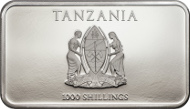January 15, 2015 – The coins, one version made in silver, the other made in gold, were designed by Coin Invest Trust and depict three monkeys crouching on a steel beam. The monkey on the left is covering his eyes, the one on the right his mouth and the one in the middle his ears.
Tanzania / 1500 Shillings / 2014 / Gold .9999 / 0.5 g / 8.5 x 15 mm / Proof / 5000 pieces.
In Japan, the three wise monkeys represent a popular proverb: mizaru, kikazaru, iwazaru. To see (no evil), to hear (no evil), to speak (no evil). For those unfamiliar with eastern philosophy, this may indeed sound like a no to civil courage. And yet, the maxim means just the opposite.
The proverb can be dated back to Chinese philosopher Confucius. About 2,500 years ago, he advocated benevolence and moral sense. Do not let yourself be influenced by evil, better even, avoid evil altogether in order not to be infected by it. This does not, however, imply you should look away when others need help, on the contrary! After all, the wellbeing of state and society were at the heart of Confucian philosophy. But what do monkeys have to do with anything?
Tanzania / 1000 Shillings / 2014 / Silver .999 / 1 oz / 27 x 47 mm / Proof / 1888 pieces.
In Early Middle Japanese, verb forms like “not see” are negated with the suffix zaru, which sounds similar to the word for monkey, saru. An ideal coincidence to create a memorable artistic representation of this moral maxim. And so the three verb forms of the saying came to mean the names of the three monkeys over the years: Mizaru, Kikazaru and Iwazaru.
The coins are minted by B.H. Mayer’s Kunstprägeanstalt GmbH. Collectors can purchase the issue through specialty dealers.
Further information on the presented coins and more interesting coins and medals you can find on the website of Coin Invest Trust.
To learn more about the story and the meaning of the three wise monkeys click here.







